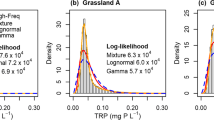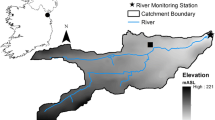Abstract
Excess nutrient loading from agricultural landscapes contributes to downstream water quality degradation. To mitigate these issues, agricultural drainage ditches have recently gained attention as potential sites for nutrient reduction. We examined the effects of vegetation and hydrology on oxidation-reduction (redox) potential. Testing occurred in an agricultural drainage ditch fitted with weirs in the summer of 2012. Redox potential was recorded using continuous automated data loggers and analyzed using both frequentist and Bayesian methods. Significant difference was found when analyzing redox potential response to vegetation (t = −1.75, P = 0.08, df = 9754) and hydrology treatments (t = 7.51, P < 0.001, df = 9754) in a frequentist manner. Vegetation and hydrologic treatments were significant when analyzed using Bayesian methods; however, the interactions of the two terms had the greatest posterior weights. This study suggests that the innovative use of vegetation and controlled drainage can affect Eh, in particular Eh heterogeneity within ditch systems. Results obtained by analyzing these data in both a frequentist and Bayesian methods were similar in terms significance and magnitude. However, Bayesian methods, and their ability to incorporate prior information into a management framework, may be better suited for systems where previous information can be incorporated into analyses.






Similar content being viewed by others
Explore related subjects
Discover the latest articles and news from researchers in related subjects, suggested using machine learning.References
Aldridge KT, Ganf GG (2003) Modification of sediment redox potential by three contrasting macrophytes: implications for phosphorus adsorption/desorption. Marine and Freshwater Research 54:87–94
Antelman G (1997) Elementary bayesian statistics. Edward Elgar, Cheltenham
Baker BH, Kröger R, Prevost JD, Pierce T, Ramirez-Avila JJ, Prince-Czarnecki JM, Faust D, Flora C (2016) A field-scale investigation of nutrient and sediment reduction efficiencies of a low-technology best management practice: low-grade weirs. Ecological Engineering 91:240–248
Brodrick SJ, Cullen P, Maher W (1988) Denitrification in a natural wetland receiving secondary treated effluent. Water Resources 22:431–439
Bulc TG, Klemenčič AK, Razinger J (2011) Vegetated ditches for treatment of surface water with highly fluctuationg water regime. Water Science and Technology 63:2353–2359
Catallo WJ (1999) Hourly and daily variation of sediment redox potential in tidal wetlands. Biological Resources Division Biological Sciences Report USGS/BRD/BSR, Lafayette
Cooper CM, Lipe WM (1992) Water quality and agriculture: Mississippi experiences. Journal of Soil and Water Conservation 47:220–223
Corbella C, Garfí M, Puigagut J (2014) Vertical redox profiles in treatment wetlands as function of hydraulic regime and macrophytes presence: surveying the optimal scenario for microbial fuel cell implementation. Science of the Total Environment 470-471:754–758
Cornelius JM, Reynolds JF (1991) On determining the statistical significance of discontinuities with ordered ecological data. Ecology 72:2057–2070
Cronk JK, Fennessey MS (2001) Wetland plants. CRC Press, Boca Raton
Cusell C, Mettrop IS, van Loon EE, Lamers LPM, Vorenhout M, Kooijman AM (2015) Impacts of short-term droughts and inundations in species-rich fens during summer and winter: large-scale field manipulation experiements. Ecological Engineering 77:127–138
Dennis B (1996) Discussion: should ecologists become Bayesians? Ecological Applications 6:1095–1103
Fiedler S (2000) In situ long-term-measurement of redox potential in redoximorphic soils. In: Schuring J, Schultz HD, Fischer WR, Bottcher J, Duijnisveld WHM (eds) Redox: fundamentals, processes, and applications. Springer, Berlin, pp 81–94
Fiedler S, Vepraskas MJ, Richardson JL (2007) Soil redox potential: importance, field measurements, and observations. Advances in Agronomy 94:1–54
Fischer WR, Flessa H, Schaller G (1989) pH values and redox potentials in microsites of the rhizosphere. Zeitschrift für Pflanzenernährung und Bodenkunde 152:191–195
Flessa H (1994) Plant-induced changes in the redox potential of the rhizospheres of the submerged vascular macrophytes Myriophyllum verticillatum L. and Ranunculus circinatus L. Aquatic Botany 47:119–129
Fredrickson LH (2007) Stratagies for water level manipulation in moist-soil systems. In: Nelms KD, Ballinger B, Boyles A (eds) Wetland management for waterfowl handbook. Mississippi River Trust, Wildlife Mississippi, NRCS, US Fish and Wildlife Service
Fredrickson LH, Reid FA (2007) Preliminary considerations for manipulating vegetation. In: Nelms KD, Ballinger B, Boyles A (eds) Wetland management for waterfowl. Mississippi River Trust, Wildlife Mississippi, NRCS, US Fish and Wildlife Service, pp 27–32
Gambrell RP, DeLaune RD, Patrick WH Jr (1991) Redox processes in soils following oxygen depletion. In: Jackson MB, Davies DD, Lambers H (eds) Plant life under oxygen deprivation: ecology, physiology, and biochemistry. SPB Academic Publishing BV, The Hauge
Gilbert PM, Maranger R, Sobota DJ, Bouwman L (2014) The Haber Bosch-harmful algal bloom (HB-HAB) link. Environmental Research Letters 9(10):105001
Goodman SN (1999) Toward evidence-based medical statistics. 1: the P value fallacy. Annals of Internal Medicine 130:995–1004
Gosz JR (1991) Fundamental ecological characteristics of landscape boundaries. In: Holland MM, Risser PG, Naiman RJ (eds) Ecotones: the role of landscape boundaries in the managment and restoration of changing environments. Routledge, Chapman & Hall, Inc., New York
Hadfield JD (2010) MCMC methods for multi-response generalized linear mixed models: the MCMCglmm R package. Journal of Statistical Software 33:1–22
Hadfield JD (2012) MCMCglmm coursenotes. R coursenotes. The R foundation for statistical computing, Vienna
Hunt RJ, Walker JF, Krabbenhoft DP (1999) Characterizing hydrology and the importance of ground-water discharge in natural and constructed wetlands. Wetlands 19:458–472
Hunter RG, Faulkner SP, Gibson KA (2008) The importance of hydrology in restoration of bottomland hardwood wetland functions. Wetlands 28:605–615
Jesperson DN, Sorrell BK, Brix H (1998) Growth and root oxygen release by Typha latifolia and its effects on sediment methanogenesis. Aquatic Botany 61:165–180
Kröger R (2010) Landscape hydrogeomorphic conditions determine structure and species composition of an ephemeral floodplain wetland. Acta Ecologica Sinica 30:280–287
Kröger R, Khomo L, Levick S, Rogers K (2009) Moving window analysis and riparian boundary delineation on the northern plains of Kruger National Park, South Africa. Acta Oecologica 35:573–580
Kröger R, Moore MT, Farris JL, Gopalan M (2011) Evidence for the use of low-grade weirs in drainage ditches to improve nutrient reductions from agriculture. Water, Soil, and Air Pollution 221:223–234
Krzywinski M, Altman N (2013) Points of significance: importance of being uncertain. Nature Methods 10:809–810
Kuhnert PM, Martin TG, Griffiths SP (2010) A guide to eliciting and using expert knowledge in bayesian ecological models. Ecology Letters 13:900–914
Laukkanen M, Ekholm P, Huhtala A, Pitkanen H, Kiirikki M, Rantanen P, Inkala A (2009) Integrating ecological and economic modeling of eutrophication: towards optimal solutions for a coastal area suffering from sediment release of phosphorus. Ambio 38(4):225–235
Light HM, Darst MR, Lewis LJ, Howell DA (2002) Hydrology, vegetation, and soils of riverine and tidal floodplain forests of the lower Suwannee River, Florida, and potential impacts of flow reductions. USGS Numbered Series 1656:1–124
López Puga J, Krzywinkski M, Altman N (2013) Bayes’ theorem: incorporate new evidence to update prior information. Nature Methods 12(4):277–278
López-Rosas H, Moreno-Casasola P, Mendelssohn IA (2005) Effects of an African grass invasion on vegetation, soil and interstitial water characteristics in a tropical freshwater marsh in La Mancha, Veracruz (Mexico). Journal of Plant Interactions 1:187–195
Malakoff D (1999) Statistics: Bayes offers a ‘new’ way to make sense of numbers. Science 286:1460–1464
Mansfeldt T (2003) In situ long-term redox potential measurements in dyked marsh soil. Journal of Plant Nutrition and Soil Science 166:210–219
Martin TG, Kuhnert PM, Mengersen K, Possingham HP (2005) The power of expert opinion in ecological models using bayesian methods: impacts on grazing birds. Ecological Applications 15:266–280
Mitsch WJ, Gosselink JG (2000) Wetlands. Wiley & Sons, New York
Mitsch WJ, Zhang L, Anderson CJ, Altor AE, Hernandez ME (2005) Creating riverine wetlands: ecological succession, nutrient retention, and pulsing effects. Ecological Engineering 25:510–527
Moore JW, Schindler DE, Scheuerell MD, Smith D, Frodge J (2003) Lake eutrophication at the urban fringe, Seattle region, USA. Ambio 32:13–18
Moore MT, Kröger R, Locke MA, Cullum RF, Steinriede RW Jr, Testa S III, Lizotte RE Jr, Bryant CT, Cooper CM (2010) Nutrient mitigation capacity in Mississippi Delta, USA drainage ditches. Environmental Pollution 158:175–184
Nikolausz M, Kappelmeyer U, Szekely A, Rusznyak A, Marialigeti K, Kastner M (2008) Diurnal redox fluctuation and microbial activity in the rhizosphere of wetland plants. European Journal of Soil Biology 44:324–333
Olila OG, Reddy KR (1997) Influence of redox potential on phosphate-uptake by sediments in two sub-tropical eutrophic lakes. Hydrobiologia 345:45–57
Pezeshki SR, DeLaune RD (1996) Responses of Spartina alterniflora and Spartina patens to rhizosphere oxygen deficiency. Acta Oecologica 17:365–378
Pezeshki SR, DeLaune RD (2012) Soil oxidation-reduction in wetlands and its impact on plant functioning. Biology 1:196–221
Prato T (2005) Bayesian adaptive management of ecosystems. Ecological Modelling 183(2–3):147–156
Rabalais NN, Turner RE, Wiseman WJ Jr (2001) Hypoxia in the Gulf of Mexico. Journal of Environmental Quality 30:320–329
Rabalais NN, Turner RE, Scavia D (2002) Beyond science into policy: Gulf of Mexico hypoxia and the Mississippi River. BioScience 52:129–142
Rabalais NN, Turner RE, Diaz RJ, Justic D (2009) Global change and eutrophication of coastal waters. ICES Journal of Marine Science 66:1528–1537
Rabenhorst MC, Hivley WC, James BR (2009) Measurements of soil redox potential. Soil Science Society of America Journal 73:668–674
Reddy KR, DeLaune RD (2008) Biogeochemistry of wetlands: science and applications. CRC Press, Boca Raton
Seybold CA, Mersie W, Huang J, McNamee C (2002) Soil redox, pH, temperature, and water-table patterns of a freshwater tidal system. Wetlands 22:149–158
Shoemaker C, Kröger R, Reese R, Pierce SC (2013) Continuous, short-interval redox data loggers: verification and setup considerations. Environmental Science: Processes and Impacts 15(9):1685–1691
Sirivedhin T, Gray KA (2006) Factors affecting denitrification rates in experimental wetlands: field and laboratory studies. Ecological Engineering 26:167–181
Sorrell BK, Partridge TR, Clarkson BR, Jackson RJ, Chagué-Goff C, Ekanayake J, Payne J, Gerbeaux P, Grainger NPJ (2007) Soil and vegetation responses to hydrological manipulation in a partially drained polje fen in New Zealand. Wetlands Ecology and Management 15:361–383
Thomas CR, Miao SL, Sindhøj E (2009) Environmental factors affecting temporal and spatial patterns of soil redox potential in Florida everglades wetlands. Wetlands 29:1133–1145
Tinker PB (1997) The environmental implications of intensified land use in developing countries. Philosophical Transactions of the Royal Society B 352:1023–1033
Valiela I, Costa JE (1988) Eutrophication of Buttermilk Bay, a cape cod coastal embyment: concentrations of nutrients and watershed nutrient budgets. Environmental Management 12:539–553
van Bochove E, Beauchemin S, Theriauly G (2002) Continuous multiple measurements of soil redox potential using platinum microelectrodes. Soil Science Society of America Journal 66:1813–1820
Vorenhout M, van der Geest HG, van Marum D, Wattel K, Eijsackers HJP (2004) Automated and continous redox potential measurements in soil. Journal of Environmental Quality 33:1562–1567
Vorenhout M, van der Geest HG, Hunting ER (2011) An improved datalogger and novel probes for continuous redox measurements in wetlands. International Journal of Environmental Analytical Chemistry 91:801–810
Walbridge MR, Lockaby BG (1994) Effects of forest management on biogeochemical functions in southern forested wetlands. Wetlands 14:10–17
Williams HG, Białowiec A, Slater F, Randerson PF (2010) Diurnal cycling of dissolved gas concentrations in a williow vegetation filter treating landfill leachate. Ecological Engineering 36:1680–1685
Zuur AF, Ieno EN, Walker NJ, Saveliev AA, Smith GM (2008) Mixed effects models and extensions in ecology with R. Springer, Berlin
Acknowledgements
The authors would like to thank the Mississippi Alabama Sea Grant Consortium, Mississippi Agricultural Forestry Experiment Station, and The Forest and Wildlife Research Center at Mississippi State University for providing funding for this project. We are grateful to Dr. Robert Reese and computer and electrical engineering students for the design and construction of the continuous redox data loggers used in this study and two anonymous reviewers.
Author information
Authors and Affiliations
Corresponding author
Rights and permissions
About this article
Cite this article
Shoemaker, C., Kröger, R. Frequentist and Bayesian Approaches to Understanding Changes in Redox Potential Due to Hydrology and Vegetation in Agricultural Drainage Ditches. Wetlands 37, 705–714 (2017). https://doi.org/10.1007/s13157-017-0901-9
Received:
Accepted:
Published:
Issue Date:
DOI: https://doi.org/10.1007/s13157-017-0901-9




